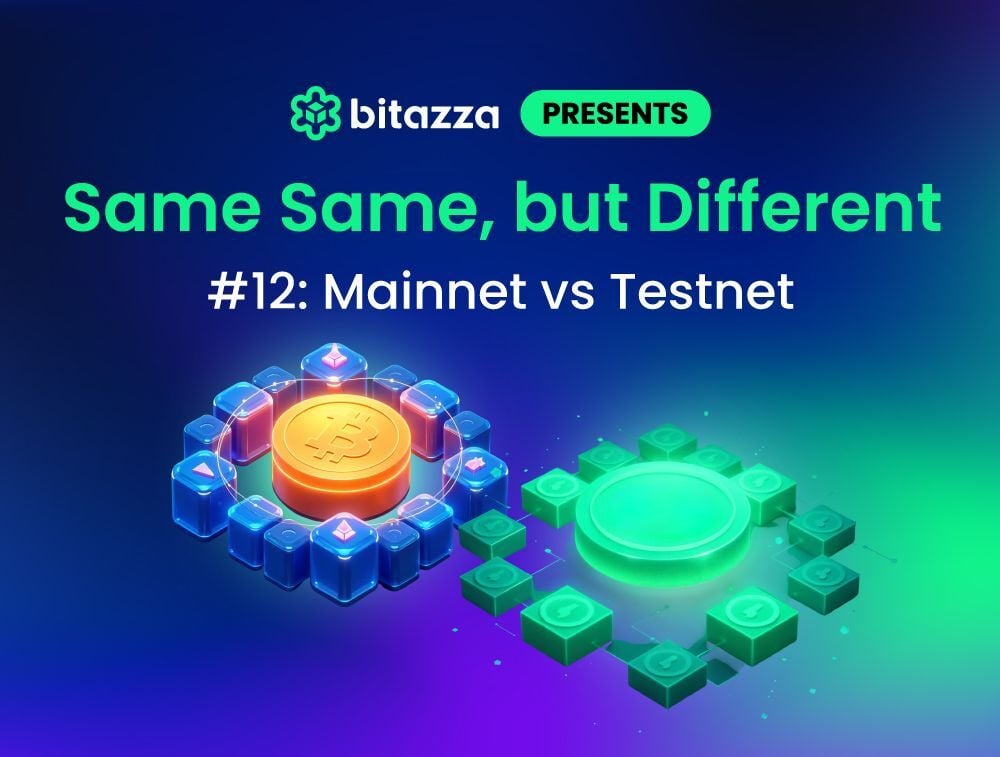Share this
Same Same, but Different #12: Mainnet vs Testnet

If you’ve recently discovered the Web3 world, or use dApps regularly, one thing you may have noticed when choosing which network to access, is the ability to select between a Mainnet and Testnet. What are they, and what do they even mean?
Before any blockchain project goes live, it needs a space for the developers to experiment, debug, and test new features. That’s where Testnets come in. But once it’s time to launch for real, then everything happens on the Mainnet.
They’re both blockchain networks that often mirror each other. However the stakes are very different. Let’s break it down.
Same Same: Both Are Blockchain Environments
Whether it’s a Mainnet or a Testnet, both are:
- Distributed blockchain networks
- Running the same protocol or codebase
- Capable of supporting transactions, wallets, smart contracts, and dApps
For developers, they serve as the backbone for development and deployment, just at different stages of the project’s lifecycle.
For example, when developers are testing a smart contract or building a new DeFi app, they will usually start on a testnet first. Once the project is ready to go live and start using real assets, it will be launched on the mainnet for regular users.
Different: Real Value vs. No Risk
Mainnet: The Real Deal
The Mainnet is the live, production blockchain where real tokens, with real value, and real users exist. This is generally the network that everyone uses for the real action.
How it works:
- Transactions are final and recorded on the blockchain
- Assets have real-world value (e.g., ETH, SOL, FDM)
- Security is critical, since any bugs could cost money
- Where actual crypto trading, staking, and DeFi happens
- Used by the public and integrated with exchanges
- Requires gas fees paid in the native token
Example: Ethereum Mainnet, Solana Mainnet, and Bitazza’s FDM token all operate in real blockchain environments where the assets are live and tradable.
Testnet: The Sandbox
The Testnet is an experimental environment, and can be viewed as a safe area for developers to try out smart contracts, upgrades, or applications without putting any real assets at risk.
How it works:
- Mimic mainnet functionalities, sometimes using dummy tokens with no value
- Great for experimenting, debugging, and learning
- Developers can simulate scenarios before deploying to mainnet
- Free to use with faucet-distributed test tokens
- Mistakes don’t cost real money
- Space to catch and troubleshoot bugs before going live
Example: Holesky, Sepolia, and Goerli are known Ethereum testnets. You can try deploying a dApp or running a smart contract without needing real ETH.
Quick Comparison Table
|
Feature |
Mainnet |
Testnet |
|
Purpose |
Live network for real use |
Testing and development |
|
Token Value |
Real (e.g., ETH, BTC, FDM) |
Fake (test tokens) |
|
Accessibility |
Public, with real users |
Developers and testers |
|
Risk Level |
High (real losses possible) |
Low (safe testing) |
|
Common Use Cases |
Trading, DeFi, NFTs, payments |
Smart contract testing, debugging |
|
Gas Fees |
Yes, paid with real tokens |
Yes, but with free test tokens |
|
Examples |
Ethereum Mainnet, Solana |
Holesky, Sepolia, Mumbai (Polygon) |
Why It Matters
Mainnets and Testnets work together to keep the crypto ecosystem secure, efficient, and innovative. If you are just a regular dApp user, then you will mostly be signed into a Mainnet. Just ensure you use a wallet that’s different from where you keep most of your funds as an added layer of security.
Use Mainnet if you are:
- Ready for real-world deployment
- Transacting with real assets
- Interacting with live dApps and tokens
Use Testnet for:
- Troubleshooting bugs while developing something new
- Experimenting new dApps without financial risk
- Testing the project before launching it to the public
For developers, testnets are like flight simulators. For users, mainnet is the real sky.
Check out more “same same but different” topics on our blog:https://blog.bitazza.com/blog
Share this
- Crypto 101 (75)
- Trading (68)
- Crypto Weekly (48)
- Educational (43)
- Bitazza 101 (41)
- Featured (19)
- Missions (8)
- Market (6)
- Bitazza Insight (5)
- Research (5)
- Derivatives (4)
- TradingView (4)
- Education (3)
- Futures Trading (3)
- Freedom Shards (1)
- Freedom Token (FDM) (1)
- Intermediate (1)
- Product and features (1)
- Tether (1)
- Tether (USDt) (1)
- crypto exchange (1)
- December 2025 (13)
- November 2025 (6)
- October 2025 (10)
- September 2025 (8)
- August 2025 (17)
- July 2025 (29)
- June 2025 (13)
- May 2025 (14)
- April 2025 (12)
- March 2025 (8)
- February 2025 (8)
- January 2025 (8)
- December 2024 (7)
- November 2024 (5)
- October 2024 (14)
- September 2024 (9)
- August 2024 (14)
- July 2024 (3)
- June 2024 (48)
No Comments Yet
Let us know what you think